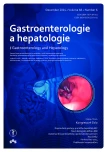An infrequent source of gastrointestinal bleeding
Authors:
J. Válek 1; B. Matějovská 2
Authors‘ workplace:
Endoskopické centrum, Interní oddělení, Česko-německá horská nemocnice Krkonoše, s. r. o., Vrchlabí
1; Interní oddělení, Nemocnice v Semilech
2
Published in:
Gastroent Hepatol 2014; 68(6): 488-491
Category:
Gastrointestinal Oncology: Case Report
doi:
https://doi.org/10.14735/amgh2014488
Overview
We present the case of a 62-year-old male who was admitted to our internal medicine department with a 6-day history of melena. Neither esophagogastroduodenoscopy nor colonoscopy identified the source of bleeding. After RBC transfusion, CT enterography was performed with suspicion of carcinoid. The subsequent double-balloon enteroscopy revealed multiple submucosal tumorous lesions in the ileum with no histologic proof of malignancy. Because of a strong suspicion of malignant etiology a surgical revision was performed together with perioperative enteroscopy and ileal resection. Carcinoid tumor was described on histologic examination of the resected ileum. The patient shows no signs of a relapse or generalized disease over a 6-month course of oncologic follow-up.
Key words:
neuroendocrine tumor – carcinoid tumor – gastrointestinal hemorrhage – balloon enteroscopy
The authors declare they have no potential conflicts of interest concerning drugs, products, or services used in the study.
The Editorial Board declares that the manuscript met the ICMJE „uniform requirements“ for biomedical papers.
Submitted:
3. 8. 2014
Accepted:
15. 9. 2014
Sources
1. Kopáčová M, Rejchrt S, Tachecí I et al. Double-balloon enteroscopy. The first fifty investigations in the Czech Republic. Folia Gastroenterol Hepatol 2006; 4(4): 135–148.
2. Havlíček K. Doporučené postupy pro praktické lékaře. Krvácení do horní části GIT. ČLS JEP 2001. [online]. Dostupné z: http://www.cls.cz/dokumenty2/os/r021.rtf.
3. Ahlquist DA. Approach to the patient with occult gastrointestinal bleeding. In Yamada T et al (ed.). Textbook of gastroenterology. 4th ed. Philadelphia: J. P. Lippincott comp 2003 : 724–738.
4. Konečný M, Ehrmann J, Procházka V. Krvácení do trávicího traktu. Postgrad Med 2004; 6 : 610–615.
5. Zavoral M. Krvácení do dolní části trávicí trubice. In: Dítě P et al (ed). Akutní stavy v gastroenterologii. 1. ed. Praha: Galén 2005 : 31–39.
6. Büschel P, Mönkemüller K, von Falkenhausen U et al. Emergency double balloon enteroscopy: a feasible and promising diagnostic as well as possible therapeutic option in recurrent midgut bleeding. BMJ Case Rep 2011. doi: 10.1136/bcr.06.2010.3068.
7. Mönkemüller K, Neumann H, Meyer F et al. A retrospective analysis of emergency double-balloon enteroscopy for small--bowel bleeding. Endoscopy 2009; 41(8): 715–717. doi: 10.1055/s-0029-1214974.
8. Yano T, Yamamoto H et al. Current state of double balloon endoscopy: the latest approach to small intestinal diseases. J Gastroenterol Hepatol 2009; 24(2): 185–192. doi: 10.1111/j.1440-1746.2008.05773.x.
9. Novák J, Šachlová M. Karcinoidy v populaci České republiky. Klin Onkol 2008; 21(2): 75–76.
10. Bosman TF, Carneiro F, Hruban RH et al. WHO classification of tumours of the digestive system. 4. ed. Lyon, France: IARC Press 2010.
11. Landerholm K, Falkmer S, Järhult J. Epidemiology of small bowel carcinoids in a defined population. World J Surg 2010; 34(7): 1500–1505. doi: 10.1007/s00268-010-0519-z.
12. Oberg K, Jelic S. Neuroendocrine gastroenteropancreatic tumors: ESMO clinical recommendation for diagnosis, treatment and follow-up. Ann Oncol 2009; 20 (Suppl 4): 150–153. doi: 10.1093/annonc/mdp158.
13. Norlén O, Stalberg P, Öberg K et al. Long-term results of surgery for small intestinal neuroendocrine tumors at a tertiary referral center. World J Surg 2012; 36(6): 1419–1431. doi: 10.1007/s00268-011-1296-z.
14. Pavel M, Baudin E, Couvelard A. ENETS consensus guidelines for the management of patients with liver and other distant metastases from neuroendocrine neoplasms of foregut, midgut, hindgut, and unknown primary. Neuroendocrinology 2012; 95(2): 157–176. doi: 10.1159/000335597.
15. Garcia-Carbonero R, Capdevila J, Crespo-Herrero G et al. Incidence, patterns of care and prognostic factors for outcome of gastroenteropancreatic neuroendocrine tumors (GEP-NETs): results from the National Cancer Registry of Spain (RGETNE). Ann Oncol 2010; 21(9): 1794–1803. doi: 10.1093/annonc/mdq022.
16. Jann H, Roll S, Couvelard A et al. Neuroendocrine tumors of midgut and hindgut origin: tumor-node-metastasis classification determines clinical outcome. Cancer 2011; 117(15): 3332–3341. doi: 10.1002/cncr.25855.
17. Boudreaux JP, Klimstra DS, Hassan MM et al. The NANETS consensus guideline for the diagnosis and management of neuroendocrine tumors: well-differentiated neuroendocrine tumors of the jejunum, ileum, appendix, and cecum. Pancreas 2010; 39(6): 753–766. doi: 10.1097/MPA.0b013e3181ebb2a5.
18. Louthan O. Neuroendokrinní tumory tenkého střeva – jejuna a ilea. Čes a Slov Gastroent a Hepatol 2009; 63(6): 284–291.
Labels
Paediatric gastroenterology Gastroenterology and hepatology SurgeryArticle was published in
Gastroenterology and Hepatology

2014 Issue 6
- Metamizole vs. Tramadol in Postoperative Analgesia
- Metamizole at a Glance and in Practice – Effective Non-Opioid Analgesic for All Ages
- Metamizole in perioperative treatment in children under 14 years – results of a questionnaire survey from practice
- The Importance of Limosilactobacillus reuteri in Administration to Diabetics with Gingivitis
Most read in this issue
- OVESCO clip as a solution of an ERCP complication
- An infrequent source of gastrointestinal bleeding
- Karlovy Vary gastroenterological – this year for the thirteenth time
- Vedolizumab – a novel anti-integrin antibody with high gastrointestinal selectivity
